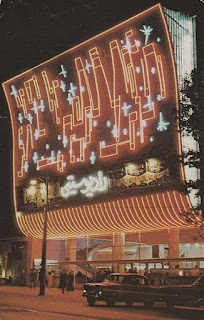Radio City Cinema was opened on 18 September 1958 in Tehran. It was designed by Heydar Ghiai (1922 - 1985), a pioneer of modern architecture in Iran. His buildings include the Moulin Rouge Cinema, the Senate Palace and the Hilton Hotel in Tehran.
The architecture of the entrance facade was designed in googie style. Red neon lights were installed on the outside of the cinema that glowed at night and gave the cinema a modern look.
The cinema had 1,400 seats and the screen had a width of 14.5 meters.
The Radio City opened with a screening of Les bijoutiers du clair de lune / The Night Heaven Fell - a 1958 French-Italian film directed by Roger Vadim with Brigitte Bardot. The cinema became one of the most visited cinemas in Tehran, showing intellectual films, most of them were US-American films.
Cinemas of the same name were built in major cities in Iran:
- the Radio City Cinema in Mashhad, opened in 1959
- the Radio City Cinema in Rasht, opened in 1965
In July 1973 a bomb incident occurred in the cinema. The cinema was burned during the Iranian revolution in November 1978 like the cinemas Capri, Chest Monde and Moulin Rouge. In the 1980s the cinema became a pharmacy for a while.
In February 2018, the cinema building was placed on the national list of monuments.
The postcard was sent in 1963. It shows the cinema advertising the movie The King and I (USA 1956).
There was a retrospective with Tarkovsky's movies in 1988 (he died in 1986) during the Fajr-Film Festival. The films were shown in Russian with no subtitles and censored. Tickets were traded on the black market, everybody wanted to see Tarkovsky. Azar Nafisi had the chance watching Tarkovsky's The Sacrifice and writes about this event:
“Looking back on that time it seems to me that such rapture over Tarkovsky by an audience most of whom would not have known how to spell his name, and who would under normal circumstances have ignored or even disliked his work, arose from our intense sensory deprivation. We were thirsty for some form of beauty, even in an incomprehensible, overintellectual, abstract film with no subtitles and censored out of recognition. There was a sense of wonder at being in a public place for the first time in years without fear or anger, being in a place with a crowd of strangers that was not a demonstration, a protest rally, a breadline or a public execution.”

Keine Kommentare:
Kommentar veröffentlichen